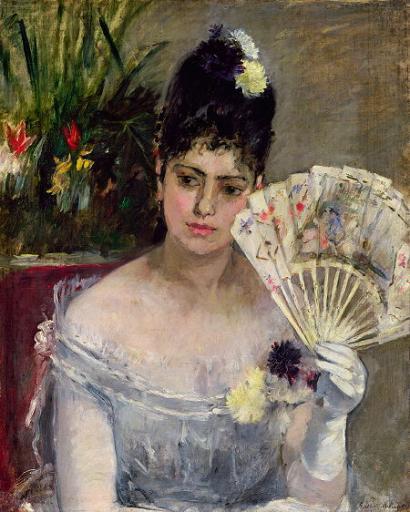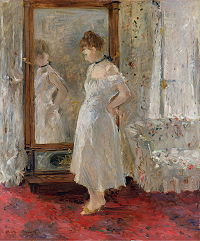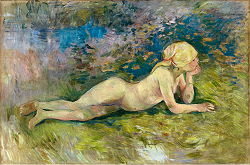
Berthe Morisot, At the ball, 1875, oil on canvas, 62 x 52 cm. Musée Marmottan Monet, Paris. |
|
MUSEO THYSSEN-BORNEMISZA
Paseo del Prado, 8. 28014 Madrid.
INFORMATION:
• Tel.+34 902 760 511
• Fax +34 914 202 780
• http://www.museothyssen.org/en/thyssen/home
OPENING HOURS:
• Tuesdays to Sundays, 10am to 7pm.
• Saturdays in 2011, from 10am to 11pm.
• Ticket desks close half an hour before the galleries are closed.
ENTRANCE FEES:
• General ticket: €5. Reduced price ticket: €3.50 for visitors aged over 65, pensioners, students, family groups
• Temporary Exhibition + Permanent Collection: general ticket: €10, reduced price ticket: €6
• Free entry: children under 12.
CURATORSHIP:
Paloma Alarcó

|
The Museo Thyssen-Bornemisza is presenting a retrospective exhibition on the work of the female Impressionist painter Berthe Morisot. Through an important agreement reached with the Musée Marmottan Monet, Paris, more than 30 works from that collection are shown alongside one loaned from the Fondatión Pierre Gianadda in Martigny (Switzerland) and others from the Thyssen collections. As a result, visitors are able to appreciate Morisot’s elegant and luminous style, expressed in landscapes, scenes of everyday life and intimate female portraits.
 Berthe Morisot, The Psyche Mirror, 1876, oil on canvas, 65 x 54 cm, Museo Thyssen‐Bornemisza, Madrid.
The thematic and chronological structure of the exhibition has been structured to run in parallel to the artist’s life and is divided into the following sections: Corot and outdoor Painting; Manet and the intimate Portrait; Painting Life, living Painting; Parks and Gardens; and The rural World. In each gallery Morisot’s works is complemented by those of other artists who played important roles in her life including Corot, Boudin, Manet, Degas, Renoir, Monet and Pissarro. Married to Manet’s brother Eugène, Berthe Morisot (Bourges, 1841 – Paris, 1895) was the first female painter to join the Impressionist group, which was the most avant-garde of its day. She participated in the now legendary First Impressionist Exhibition of 1874 and in other subsequent ones organised by the group.
Starting from the Psyche Mirror
Morisot is a unique case in the history of 19th century art in that she was a woman born into an upper-middle-class French family who succeeded in establishing an important career as an artist and one associated with a new movement that was widely rejected at the time. The Psyche Mirror, from the Museum’s Permanent Collection, was one of the paintings that Morisot presented at the Third Impressionist Exhibition of 1877 and has now provided the inspiration for the present exhibition. Executed with a delicate handling of soft brushstrokes, it depicts a young woman dressing herself in a leisurely manner before an Empire style mirror, which was a piece of furniture that belonged to Morisot and which is now in the collection of the Musée Marmottan Monet, along with other items that belonged to the artist.
 Berthe Morisot, Reclining nude shepherdess, 1891, oil on canvas, 57,5 x 86,4 cm. Colección Carmen Thyssen‐Bornemisza, on loan to Museo Thyssen‐
Bornemisza.
Morisot was always particularly interested in the study of light and colour, and also shared the other Impressionists’ focus on reflections of light. Her independent, even rebellious nature is evident in her work and the exhibition extends its focus to the role of women in late 19th-century France as Morisot was not just a great creative figure but also an urban, middle-class woman interested in fashion and in the active cultural life of the day, associating with intellectuals and artists such as Manet, Renoir, Monet, Pissarro, Degas and Mallarmé. Her focus on the depiction of the universe of female emotions and sensibilities was so intense that her friend the French poet Paul Valéry used to say that she “lived her painting and painted her life”.
To see more illustrations, click on VERSION FRANCAISE at the top
of this page
|










